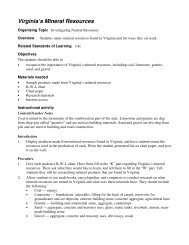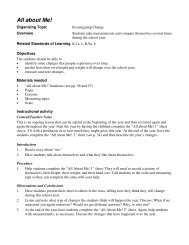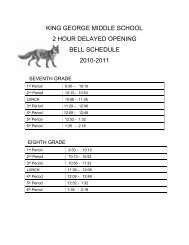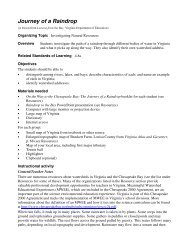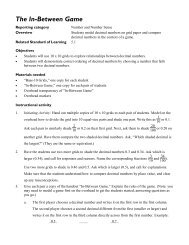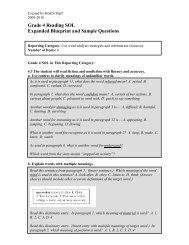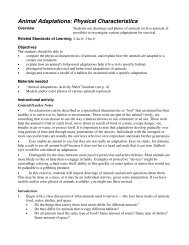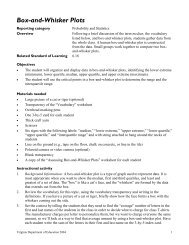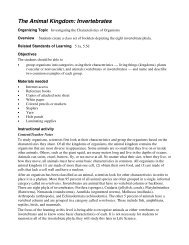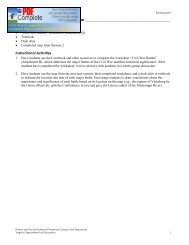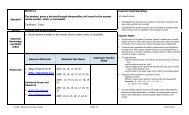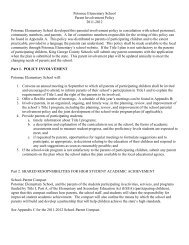Create successful ePaper yourself
Turn your PDF publications into a flip-book with our unique Google optimized e-Paper software.
<strong>Henry</strong> <strong>Heron</strong>: A <strong>Litter</strong> <strong>Story</strong><br />
Organizing Topic<br />
Overview<br />
Related Standards of Learning 1.8a, b, c<br />
Objectives<br />
Investigating Natural Resources<br />
Students listen to a short story and then sequence the order of<br />
the story’s events and predict a conclusion.<br />
The students should be able to<br />
• identify natural resources such as plants and animals, water, air, land, minerals, forests, and<br />
soil;<br />
• compare and contrast ways of conserving resources. This includes recycling, reusing, and<br />
reducing consumption of natural resources;<br />
• describe ways students and schools can help improve water and air quality in our<br />
communities;<br />
• discuss the value of parks to wildlife and to people.<br />
Materials needed<br />
• Six-pack plastic ring<br />
• “<strong>Henry</strong> <strong>Heron</strong>” story (see next page)<br />
Instructional activity<br />
Content/Teacher Notes<br />
Animals need food, water, air, and space. The water and the space must be clean and free of litter to<br />
provide a safe and healthy habitat.<br />
Introduction<br />
Ask for a show of hands of students who have recently visited a park with a lake. Discuss the things<br />
they saw around the lake, eventually guiding the discussion toward trash or litter they might have<br />
seen. List all litter items the students remember seeing. Ask: Was this litter ugly there? Did it make<br />
the park look bad? Was it dangerous to you? To other people? To animals? Guide the discussion<br />
toward any birds the students may have seen and how the litter might hurt the birds and other<br />
animals.<br />
Procedure<br />
1. Read “<strong>Henry</strong> <strong>Heron</strong>: A <strong>Litter</strong> <strong>Story</strong>” to the class, stopping in the middle to have students<br />
predict what will happen to <strong>Henry</strong>. After finishing the story, discuss how <strong>Henry</strong> might have<br />
felt, how the people helping <strong>Henry</strong> might have felt, and what might have happened differently.<br />
2. Slip a large rubber band onto your thumb and little finger over the back of your hand. Ask the<br />
students if they think it will be easy for you to remove the rubber band without using your<br />
other hand. Demonstrate how hard this is to do. Let several or all of the students try, and<br />
discuss how hard it is to remove the rubber band. Talk about how animals have trouble<br />
removing items that get caught around their feet or necks since they don’t have hands and<br />
fingers to help remove the items.
3. Show a six-pack ring, and pass it around so students can try to tear it to see how strong it is.<br />
Tell the students that years ago when garbage was often dumped in the sea, people<br />
recommended cutting rings before disposing of them so that they could not hurt birds and<br />
other animals. These days trash in Virginia is recycled, put in landfills, or incinerated.<br />
Therefore, when these rings are recycled or disposed of properly, cutting them is not<br />
necessary.<br />
Sample assessment<br />
• Ask students the following questions:<br />
° What are some examples of litter?<br />
° How can litter be dangerous?<br />
° What can you do to lessen the amount of litter?<br />
Follow-up/extension<br />
• Have students suggest their own ending to the story, or have them retell the story. Students<br />
may also illustrate their endings.<br />
• Have students draw a cover picture for the <strong>Henry</strong> <strong>Heron</strong> story that suggests what happens.<br />
Resources<br />
• Pollution Solutions: <strong>Litter</strong> Prevention Activities for Virginia Teachers. Virginia Resource-Use<br />
Education Council. http://www.deq.state.va.us/education/polsul/homepage.html. This lesson<br />
is adapted from this source.<br />
• Outstanding Science Trade Books for Students K–12. National Science Teachers Association<br />
(NSTA). http://www.nsta.org/ostbc.<br />
• Search for Literature: Literature for Science and Mathematics. California Department of<br />
Education. http://www.cde.ca.gov/ci/sc/ll/ap/searchlist.asp. Web site with searchable database.<br />
HENRY HERON: A LITTER STORY<br />
<strong>Henry</strong> is a heron. He likes to hang out at the park’s lake. He often<br />
stands as still as a statue and waits for minnows to swim by so he can<br />
grab a quick snack.<br />
<strong>Henry</strong> is a very curious heron and always explores the nooks<br />
and crannies of the lakes and rivers he visits. One day <strong>Henry</strong><br />
saw something stuck in the grass near the edge of the lake. “I<br />
wonder what that could be?,” he thought excitedly as he went closer.<br />
“Oh, it’s only a soda can,” he sighed. “Another piece of trash<br />
left by a lazy person. I don’t know why people can’t be neater!!”<br />
Just as he was about to wade away, <strong>Henry</strong> saw a minnow<br />
skimming through the water. He did exactly what comes naturally<br />
to herons. His head went down and he came up with the minnow<br />
in his beak. “Yum!,” he said as he swallowed the minnow. “I love<br />
good food.”<br />
Then <strong>Henry</strong> noticed he had caught more than just the minnow. The minnow had gone beneath a<br />
plastic six-pack ring, and as <strong>Henry</strong> had reached to get it, his head had gone through the ring. It<br />
was stuck on his long neck!
<strong>Henry</strong> shook, he wiggled, he rubbed against the grass, he stuck his head into the water, but<br />
nothing he did would remove the plastic ring. “This is terrible, horrible, awful,” <strong>Henry</strong> announced<br />
to the world. But no one was listening. <strong>Henry</strong> gave one more long, lonely shake of this head.<br />
Morning dawned, and <strong>Henry</strong> stretched, but was brought up short. The plastic ring pulled and<br />
squeezed his neck, and made it very hard for <strong>Henry</strong> to breathe. Then some park visitors saw<br />
<strong>Henry</strong>. They chased him, trying to catch him. We know they just wanted to help <strong>Henry</strong>, but all<br />
<strong>Henry</strong> knew was that he was scared and wanted to get away. He wished he could disappear. He<br />
flew away and landed in a nearby clearing.<br />
After a while <strong>Henry</strong> got hungry and came out to the middle of the lake. He tried to catch some<br />
fish, but the plastic ring kept getting in the way, or it moved and scared the minnows away. How<br />
could he catch some fish? <strong>Henry</strong> flew to the shore, still hungry. When he got there, he was again<br />
chased by people. This time, the people were in uniforms.<br />
The next day <strong>Henry</strong> was tired, hungry, and terribly discouraged. He went over to the other<br />
herons. They also chased him away. “You’re scaring all the fish away. You’re making people<br />
chase us. You look stupid with that plastic ring thing around your neck!”<br />
“I didn’t get it stuck on myself on purpose,” <strong>Henry</strong> said. “I tried to get it off.” But the herons just<br />
flapped their long wings and left <strong>Henry</strong>. One of them even pecked at <strong>Henry</strong>, and you know that<br />
had to hurt!<br />
(Teacher Note: Stop here. Ask the students to predict what they think might happen to <strong>Henry</strong>.)<br />
<strong>Henry</strong> was resting quietly in a cove of reeds when suddenly he was covered with a net. He<br />
flapped and struggled, but he couldn’t get away. When hands reached for him, he snapped at<br />
them with his long beak. The people wouldn’t give up. They finally got a good hold on <strong>Henry</strong> and<br />
tried to calm him. They held his neck very still and clipped the plastic ring and then pulled it off.<br />
When they released <strong>Henry</strong>, he flapped his wings and flew across the lake. Once he had calmed<br />
down, he realized the people had helped him and had removed the plastic ring.<br />
“Yes,” he said. “I can eat again! I can drink!” and he dipped his head into the water. “I can sleep<br />
and eat and do almost anything!!!” <strong>Henry</strong> was so excited!<br />
Note to teachers<br />
It would be nice to say to the students that <strong>Henry</strong> is safe for the rest of his life, but since there is so<br />
much litter around, that probably is not the case. Many animals never get rescued in the first place,<br />
and those that do may get caught in litter again. Animals probably do not realize that litter is<br />
dangerous to them, and they often do not remember what has happened to them in the past like<br />
people do. They may even think a piece of litter looks like something interesting to eat and go after<br />
it on purpose. We can help by always putting our trash in the right places.



